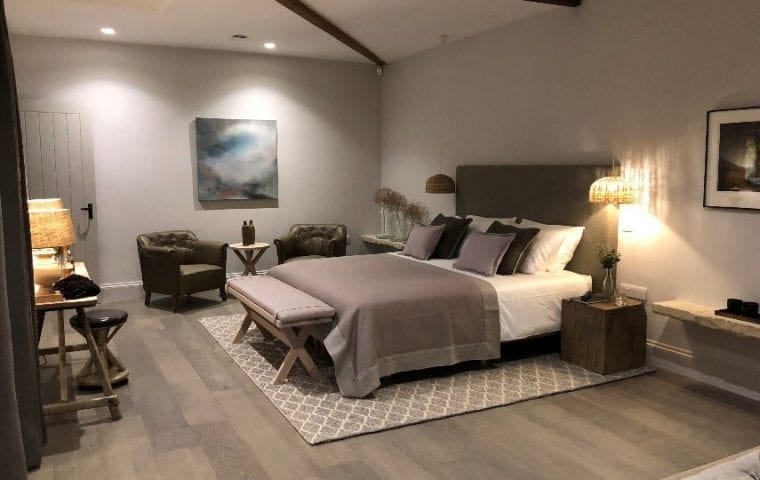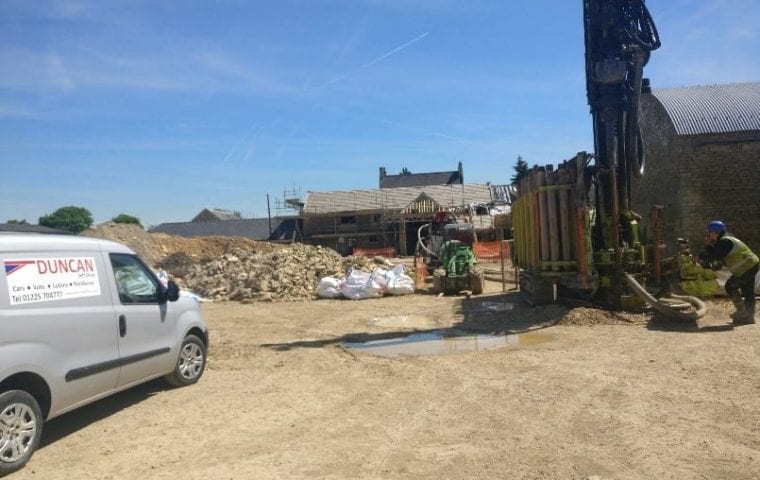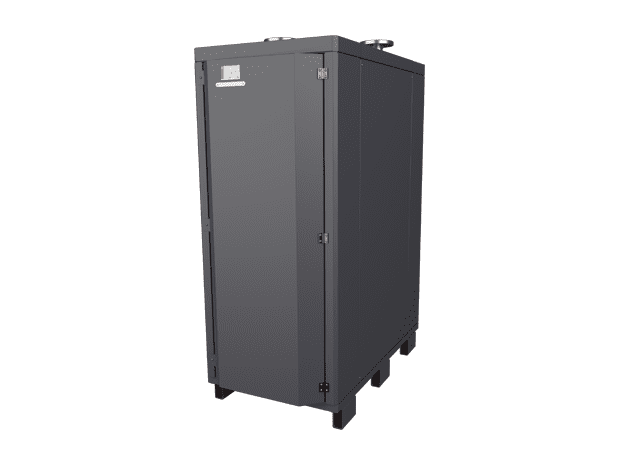Bibury Barns

Ground source review: Bibury Barns
Five derelict stone barns on a picturesque Cotswold Farm were converted into luxury holiday lets, Bibury Barns, featuring eco-friendly and efficient ground source heat pump technology from Kensa.
This conversion won Greengauge Building Energy Consultants ‘Retrofit Project of the Year’ at the H&V News Awards 2019.
Ground source review: Bibury Barns
Read this interview with the key people involved in this award-winning renovation project:

- Owner, George Phillips
- Hannah Jones, Greengauge Building Energy Consultants
- Jonathan Nettleton, Blake Architects
- David Billingsley, Kensa Heat Pumps
Why did you decide to convert the barns?
Owner, George Phillips explained:
We were only maintaining the roofs of the barns to keep them watertight – there was no longer a use for them. But they could potentially be an asset. Our intention was to keep the barns in our ownership, and long term lets would not achieve the income requirements in order to service borrowings required to complete the project. From a business point of view, because the Cotswolds is such a popular area, we decided holiday lettings would be the best route.”
What was the brief for the build?
Hannah Jones from Greengauge Building & Engineering Consultants said:
One of George’s main concerns was that the holiday lets should be comfortable. Trying to heat a draughty, stone-walled building to a liveable temperature can often mean you run the heating at a very high temperature – leading to hot spots and cold spots, as well as high bills. We wanted to avoid this, and make the spaces comfortable and cost effective to run.”
How did you obtain planning permission?
Jonathan Nettleton from Blake Architects said:
Building conversions carried out in an AONB such as the Cotswolds are subject to strict planning conditions – and the barns at Bibury Farm are also within the curtilage of a listed building (the old farmhouse).
The buildings divided themselves quite neatly to make five dwellings without needing to subdivide them. Because of the planning constraints, we could only make limited changes outside. But the conservation team at Cotswold District Council were very helpful and proactive.”
How did you keep heat losses to a minimum?
Hannah from Greengauge said:
The planning team were keen to see low CO2 emissions, and we favoured the approach of insulating internally to reduce energy demand.”
If we insulated and paid attention to airtightness, and installed MVHR, we could get the heat demand low enough to make it possible to heat via underfloor heating – which fits in so much better with a luxury project like this. Using lots and lots of radiators would have spoilt the internal appearance.”
Why was a ground source heating system chosen?
Hannah from Greengauge said:
Lowering the heat load enough to permit underfloor heating opened the door to low-carbon heating. This meant it was possible to opt for a heat pump – further reducing emissions, so that all tied together really well.”
George agreed:
The planners were looking for a low-carbon system, and it was also beneficial to let guests know that the holiday lets have a low carbon footprint. We looked into various approaches, including installing solar panels next door, but heat pumps worked out as the best in the end. We rejected air source heat pumps, as it would have been quite difficult to integrate these nicely into the development. There would potentially be issues of noise where dwellings had just a little courtyard, and they aren’t the most attractive.”
What type of ground array was used?
George explained:
The only available open space was reserved for potential later development and the surrounding fields are managed under a different business, so it would have been difficult to fit in a large horizontal loop slinky ground array. So instead we went for boreholes which were drilled under the pathways outside each property, so it’s all very neat. We had to drill 13 boreholes, which was quite an undertaking, but we were able to get financial help from the Renewable Heat Incentive (RHI*).”
What benefits does a shared ground loop array infrastructure bring?
Hannah from Greengauge explained:
The cluster of buildings could have lent itself to one centralised plant room for heat. But everyone was keen to avoid a massive boiler if possible, and with no gas in the rural location, this would have probably meant oil, which can be both noisy and smelly, as well as requiring an unsightly tank. The preference was for individual heating systems, to keep open the option to sell the barns as private homes in the future.
“We talked to Kensa Heat Pumps and established that we could link individual ground source heat pumps inside each property to a communal ground array acting as a shared energy source, removing the need for any central plant.
David Billingsley, Kensa Sales Manager, explained the system set up:
The heat pumps are linked to an innovative shared ground loop array system which enables each property to have independent heating, and provides the owners with a generous 20 year income from the Non Domestic Renewable Heat Incentive (RHI*). Each Kensa ground source heat pump upgrades heat energy from the ground to provide every holiday let with independently controllable heat and hot water to the property.
How are the heat pumps controlled?
Hannah Jones explained:
“The heating has to more or less run itself – occupants staying only a few days don’t get the chance to familiarise themselves with the controls. Because underfloor heating is slower to respond than a conventional radiator system, there is always a danger that people will overshoot when they alter the thermostat. So the strategy is to give the occupants no control over main underfloor heating system, but just keep it running at a steady 20 degrees. For the same reason, the heating will only be set back a couple of degrees when units are empty, so it doesn’t take too long to heat them up again.
What is your feedback on the heating system?
George said:
The comfort levels achieved in the barns are better than I had dared to hope, I’m amazed by how warm they are! One of my biggest concerns with heat pumps was that it would take three or four days to warm them up, because they run at a low temperature. However the barns are remarkably well insulated, so what I hadn’t appreciated was that when I went to turn the heat up, it didn’t take long to get them to temperature at all. In fact we’ve had to turn it down!
Laughing, he added:
The barns are far more comfortable than my house. Maybe one day I’ll be able to move into one!”
*Please note, the RHI scheme has now closed – please visit this page to explore other funding.


Bibury Farm Barns ground source heat pump case study: external front aspect


Bibury Farm Barns ground source heat pump case study: internal master bedroom


Bibury Farm Barns ground source heat pump case study: internal kitchen diner


Bibury Farm Barns ground source heat pump case study: external scaffolding during renovation


Bibury Farm Barns ground source heat pump case study: mid external renovation works


Bibury Farm Barns ground source heat pump case study: borehole drilling


Bibury Farm Barns ground source heat pump case study: external pic before renovation






